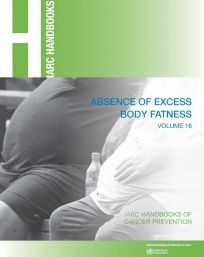
978-92-832-3018-2
978-92-832-3020-5
View summary report as HTML or PDF
View French version of The NEJM summary (hosted by Centre Léon Bérard)
A Working Group of 21 independent experts from 8 countries, convened by the International Agency for Research on Cancer (IARC) in April 2016, reviewed the scientific evidence and assessed the cancer-preventive effects of the absence of excess body fatness.
The mean body mass index (BMI) in the adult population has increased dramatically worldwide over the past 40 years, and IARC recently estimated that close to 4% of all new cancer cases in adults were attributable to a high BMI; the number of cases is highest in high-income countries and is expected to rise in low- and middle-income countries.
This publication provides an important update of the 2002 IARC Handbook on Weight Control and Physical Activity, with evidence-based evaluation of the association between excess body fatness and cancer at more than 20 sites. In addition, the Working Group reviewed the evidence on childhood obesity and cancer in later life, the impact of excess body fatness in cancer patients on cancer survival and recurrence, and the few intervention studies of weight control on cancer outcome.
2. Cancer-Preventive Effects in Humans
2.1. Methodological considerations
2.2. Cancer-preventive effects by organ site
2.2.1. Cancer of the colorectum
2.2.2. Cancer of the oesophagus
2.2.4. Cancer of the liver (hepatocellular carcinoma)
2.2.5. Cancer of the gall bladder
2.2.6. Cancers of the biliary tract
2.2.9. Cancer of the breast in women
2.2.10. Cancer of the breast in men
2.2.11. Cancer of the endometrium
2.2.14. Cancer of the prostate
2.2.16. Cancer of the kidney (renal cell carcinoma)
2.2.17. Cancer of the urinary bladder
2.2.18. Primary tumours of the brain and central nervous system
2.2.20. Haematopoietic malignancies of lymphoid origin
2.2.21. Other haematopoietic malignancies
2.2.22. Cancers of the head and neck
2.3. Excess body fatness in early life and subsequent cancer risk
2.4. Excess body fatness in cancer survivors
2.5. Sustained weight loss and cancer risk: illustrative examples
3. Cancer-Preventive Effects in Experimental Animals
These tables were produced in draft form by the Working Group and were subsequently edited but have not been fact-checked. Please report any errors to ihb@iarc.fr.